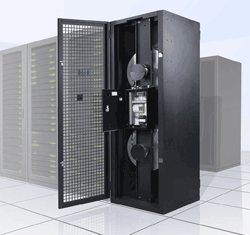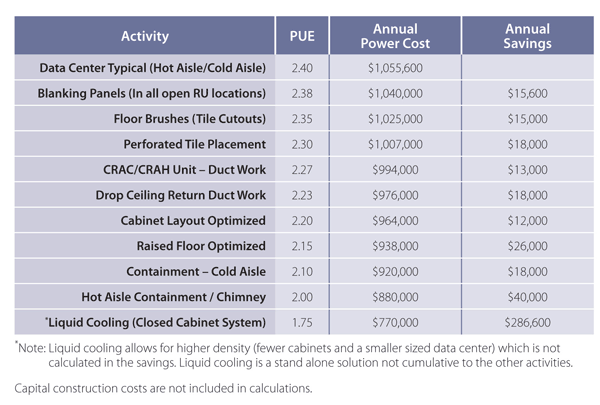A scalable cooling strategy to meet current and future thermal management requirements
Here are the key questions to ask when addressing cooling concerns
BY MARC CAIOLA
Vertical Market Manager, Communications
Pentair Technical Products
www.hoffmanonline.com
The speed of technological changes has resulted in substantial new challenges for data centers, and realizing goals of increased processing capacity, greater efficiency, a smaller physical footprint and reduced operational costs are met with many consequences. For instance, higher rack densities lead to increased exhaust heat, which must be minimized in order to maintain optimal equipment performance.
According to the Uptime Institute, heat build-up significantly diminishes server performance and equipment lifespan. For every 18° that internal cabinet temperatures rise above normal room temperature, the life expectancy of the enclosed electronics drops 50%. As a result, today’s IT and data center managers must implement scalable, energy-efficient thermal management solutions that will meet current requirements and allow for future infrastructure growth.

Determining data center efficiency
An effective cooling solution will significantly contribute to maximizing power usage effectiveness (PUE) and data center infrastructure efficiency (DCIE) performance. PUE measures how efficiently a data center and IT infrastructure use power. Essentially, PUE compares the total amount of power used by the data center to the power used by the IT equipment. A low PUE measurement result indicates an efficient data center. Typical hot aisle/cold aisle (HACA) configurations may have a PUE result of approximately 2.4. However, by implementing efficiency initiatives, the PUE can be lowered, with purpose-built data centers boasting PUE results as low as 1.75.

Table: Power Usage Effectiveness: Costs and Savings
DCIE is a similar but inversely related concept, and another performance metric used to determine data center efficiency. DCIE is used to calculate the energy efficiency of the data center by dividing IT equipment power by total facility power. With DCIE, the higher the resulting figure, the greater the efficiency. Achieving low PUE and high DCIE performance measurements can dramatically reduce the energy costs associated with operating a data center.

For companies that achieve low PUE and high DCIE, the most significant challenges to maintaining a functional data center are adaptability and scalability. Data center and IT managers can work to overcome these challenges by conducting an energy audit.
Through this audit, managers will be able to accurately measure energy consumption levels and pinpoint areas for improvement. Facilities typically find that their data center consumes anywhere from 8% to 30% of all enterprise energy.
In addition to conducting an energy audit, managers should consider key questions when addressing cooling concerns. For instance, while up-front investment is an important factor, managers should consider the total cost of ownership of the cooling solution throughout its lifecycle as part of the initial price. By answering the following questions, managers can better address cooling concerns within the data center environment.
• What is the cost/benefit associated with deploying the cooling solution vs. adding to existing cooling plant?
• What is the cooling medium — air-to-air, air — to-water, other?
• How much airflow (CFM) does the cooling solution deliver?
• How will the cooling solution improve our current PUE and DCIE?
• What is the power consumption of the cooling solution—watts/hr.?
• What is the annual operating cost of the cooling solution?
• What is the noise level—how much additional noise will this add to the room?
• What is the maintenance schedule — how much (and how often) maintenance is required?
• How the cooling solution is installed — overhead, in-row, in-room, in-rack, etc.?
Scalable in-row cooling
Growing thermal management requirements can be calculated through watts-per-rack and other cooling measurements. This information is used to identify and mitigate hotspots to isolate cooling issues and maximize cooling efficiency. If hotspots are found, dedicated, high-precision cooling units may be added to an existing design to solve increasing cooling needs.
For example, row-based cooling architectures featuring in-row cooling units may provide an ideal solution for modular data centers and evolving requirements, since they support easy scalability and can be implemented based on demand. The in-row cooling units provide supplemental cooling and can be deployed close to hot running equipment — such as high-density servers — without the need to add or modify HVAC or CRAC cooling systems.
While these units can provide a stand-alone solution for rooms with limited cooling requirements, they are primarily used to supplement cooling systems, increasing efficiency in both raised-floor and non-raised-floor data centers. The addition of in-row cooling units to data center infrastructure meets the increased demand of today’s higher power density equipment. Plus, since they offer efficient cooling and distribution of cool air — where the cool air is needed most—these units greatly reduce energy consumption, offering an environmentally friendly solution.
Looking ahead
Networking equipment will continue to break through speed and power boundaries, which will require data center cooling strategies to evolve to prevent overheating and subsequent equipment malfunction. However, the challenge for data center and IT managers will be implementing solutions that effectively cool and increase overall data center efficiency. ■
About the author
Marc Caiola holds a Bachelor of Science in Business/Marketing and he has over 20 years of high-technology marketing, business development and management experience within the industrial, telecommunications, and data communications market sectors.
Advertisement
Learn more about Pentair Electronics Protection, Schroff





